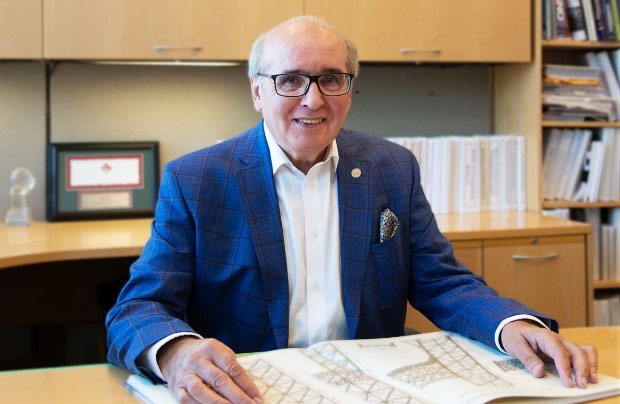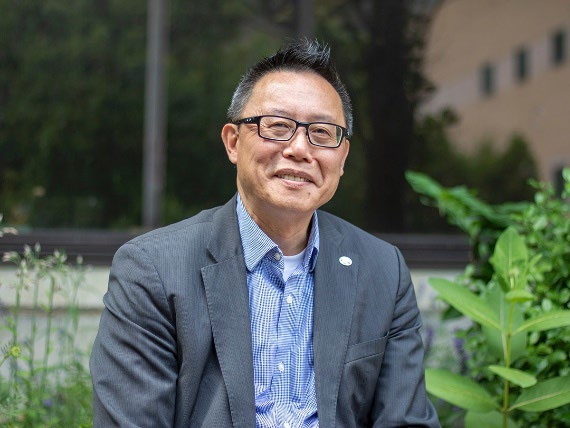
FOR IMMEDIATE RELEASE
OTTAWA, April 26, 2024 – The Royal Architectural Institute of Canada (RAIC) is proud to announce the new and exciting initiative designed to support Canada’s architectural community through the expert knowledge of our members and colleagues.
Since the inception in 2023, RAIC Advisors to Professional Practice (RAPP) engage the knowledge and experience of subject matter experts, including architects, educators, and collaborating professionals, to guide, develop, and maintain appropriate resources to support architectural practice in Canada. The RAPP provide insight into the evolution and challenges of architectural practice in Canada to inform advocacy initiatives and the practice advisory services offered by the RAIC with the goal of fostering excellence in the architectural profession.
The RAPP will contribute to the overall quality and reputation of Canadian architects in Canada and on the global stage.
"Our new RAIC Advisors to Professional Practice is a testament to our members’ dedication to the continuous improvement of the architectural profession in Canada," said Jason Robbins, President of the RAIC. "These advisors are not only leaders in their fields but also passionate advocates for the advancement of Canadian architecture. They bring a wealth of knowledge, experience, and agility that will be invaluable to our members and the architectural community."
"The RAIC Advisors to Professional Practice are here to serve as mentors, consultants, and educators to the RAIC," said Mike Brennan, RAIC Chief Executive Officer. "We believe this initiative will be a cornerstone for professional support and will ultimately lead to a stronger, more cohesive architectural community."
Silvio Baldassarra 
Silvio Baldassarra is an innovative design architect recognized by his unique architecture/engineering approach to large-scale complex projects during his 45-year career. His experience spans all sectors including aviation, commercial, education, institutional, justice, sports and transportation. Silvio is the Chair Emeritus of NORR and continues to lead, design and manage major projects and to build new project sectors. Silvio was recognized by his peers in 2010, becoming a Fellow of the Royal Architectural Institute of Canada. In 2017, he was the Innovative Architecture Award recipient in the Premio Laziale dell`Anno 2017 by the Lazio Federation of Ontario. In 2019, Silvio was awarded the Ordine al Merito by the National Congress of Italian Canadians in recognition of outstanding achievement in architecture. Silvio is a registered Architect in Ontario and 5 other Canadian Provinces. Personally, he is a Knight of Columbus and holds a 4th degree in the Blessed Trinity Parish in Toronto.
Anna Batebe, MRAIC 
Anna Batebe is a professional architect who has worked with firms such as Zeidler and Stantec. An alumni of the University of Calgary, Anna has also served as a member of the committee of the Alberta Association of Architects, as well as of the syllabus National Advisory Council of the Royal Architectural Institute of Canada. Anna is a sessional lecturer at the University of Calgary School of Architecture, Planning and Landscape.
Lawrence Bird, MRAIC 
Lawrence is a Sessional Instructor at the Department of Architecture, University of Manitoba. He serves on the Board of Directors for Manitoba’s Green Action Centre and the City of Winnipeg Urban Design Advisory Committee. At Sputnik Architecture Inc. (2019—present), he has been contributing to city planning and architectural development for projects such as the Canadian Fossil Discovery Centre, Riverwood House Transitional Housing, Rideout Bay Housing Masterplan, and Warming Huts 2019. At pico ARCHITECTURE Inc. (formerly Ager Little Architects) (2016—2019), he was responsible for the design and construction of projects like Robson Hall Audio Visual Upgrades and Apotex Building Lecture Theatre at the University of Manitoba, as well as Westgrove entrance canopy and upgrades at the Manitoba Developmental Centre in Portage la Prairie. As an Urban Design Consultant to Gem Equities (2012—2016), he worked on urban design and master planning projects for The Parker Lands and The Yards at Fort Rouge, residential infill Transit Oriented Development projects, with approximately 4,500 dwelling units. Lawrence has co-edited books including "Warming Huts" and "Re-Imagining Winnipeg." He is actively involved in architectural and urban development.
Andrea Lee, MRAIC 
Andrea Lee is certified as a Specialist in Construction Law by the Law Society of Ontario. She is a Fellow of the Canadian College of Construction Lawyers and Past Chair of the Ontario Bar Association, Construction and Infrastructure Section Executive.
Andrea obtained her Bachelor of Architecture from the University of Toronto and a Bachelor of Law from Queen’s University. She has practiced exclusively in construction law since her call to the bar in 2006. She acts for owners, contractors, design professionals and insurers in complex disputes involving claims for breach of contract, negligence, liens, breach of trust, cost overruns, delay and deficiencies. Andrea regularly advises parties in the industry with respect to construction contracts and professional design agreements.
Andrea is a co-founder of the construction law course at Queen's University and teaches construction law as part of Osgoode's LL.M program. She is also a skills instructor at The Advocates' Society. Andrea regularly speaks at programs offered by the legal and industry associations, published articles and papers on construction law topics and co-authored chapters focused on design professionals in Halsbury's Laws of Canada, Construction and Review of Construction Law: Recent Developments. Andrea is the co-editor and co-author of the text, Critical Issues in the Canadian Law of Architects and Engineers (Toronto: Thomson Reuters, 2023) and has also co-edited Bidding and Tendering, What is the Law? (6th edition).
Andrea has completed her LEED certification and RICS Diploma in construction adjudication. She is a board member of Building Transformations and volunteers on the Royal Architectural Institute of Canada, Practice Support Committee. Andrea is a mentor to young lawyers through the OBA mentorship program and the Federation of Asian Canadian Lawyers. She has been recognized by Lexpert, Benchmark Litigation, Who’s Who Legal and Best Lawyers.
Yew-Thong Leong, FRAIC 
Frank Lloyd Wright has legions of fans, and Yew-Thong Leong is one of them. As a teen, he discovered the architect’s most famous project, the private home known as Fallingwater. “It fascinated me,” he says, “and it inspired me to pursue this profession.” Today, Leong’s portfolio is full of successes and collaborations with world-renowned architects. Including Wright himself.
From 2017 to 2021, Leong will be leading a once-in-a-lifetime project: reconstructing Wright’s Banff National Park Pavilion. Completed in 1914, the structure succumbed to the ravages of flooding and frost, and was torn down in 1939. To bring it back to life, Leong and his team (which includes six other Toronto Met professors and several grad and undergrad students) will need to make some improvements to the original design. A new foundation is a possibility, as are other structural changes. But Leong will do everything he can to ensure that all modernizations are true to Wright’s vision, right down to replicating the fieldstones' exact sizes and shapes. “As a heritage preservationist and a fan of Wright’s, I have a moral responsibility to get it right.”
Henry Tsang, FRAIC 
Dr. Henry Tsang is an acclaimed Canadian architect, researcher and educator. Dr. Tsang is a tenured associate professor in the RAIC Centre for Architecture at Athabasca University, based in Alberta, Canada. His design, teaching and research work explores the intersections between sustainability, IDEA (inclusion, diversity, equity, accessibility), health and well-being, and cultural heritage in the built environment. Henry has cumulated over his 18-year career a diverse portfolio of design projects and extensive global experience. Prior to his current role, he was a visiting assistant professor of architectural engineering at Keimyung University in South Korea and director of sustainable architecture program at Herzing College in Montreal. He also often serves as guest lecturer and design critic at universities worldwide, including Hanyang University (South Korea), the Hong Kong Polytechnic University (Hong Kong), Shibaura Institute of Technology (Japan), University of British Columbia (Canada), University of Calgary (Canada), Concordia University (Canada), McGill University (Canada), and the Academy of Art University (USA). He has also spoken at TEDx, United Nations, the Architectural Institute of Korea, the Royal Architectural Institute of Canada, the Urban Land Institute Asia-Pacific Summit, Bow Valley Sustainable Building Summit, the Metropolis Identities Summit, Construction Specifications Canada Conference and many more. Tsang completed his B.Sc.Arch. and M.Arch. at McGill University, and Ph.D. at the University of Tokyo as a Japan-funded Monbukagakusho Scholar. He is the recipient of the NACC Educator of the Year Award, Canadian Architect Award of Excellence, Construction Canada Emerging Leader Award (two categories) and Robert Fung International Award of Distinction. He has also be appointed as Fellow of the Royal Architectural Institute of Canada and 2023 CBC Calgary Asian Changemaker.
The RAPP is designed to address a wide array of professional needs, including:
- Management of Practice Queries: The RAIC has established a dedicated platform to address practice queries, providing architects with valuable insights and guidance to navigate complex industry challenges effectively.
- Maintenance and Creation of Standard Agreement Documents: Efforts are underway to streamline the process of creating standard agreement documents, ensuring clarity and consistency in contracts between architects and clients, as well as architects and consultants.
- Maintenance of Existing Publications: The RAIC is committed to maintaining the quality and relevance of existing publications such as the Fee Guide and CHoP (Canadian Handbook of Practice), serving as essential resources for industry professionals.
- Contributions to RAIC Publications: RAIC members are actively contributing to various publications including the bulletin, website, and social platforms, sharing expertise and insights to enrich the architectural discourse.
- Representation in Industry Groups: The RAIC continues to represent the architectural community in key industry bodies such as the Construction Industry Council, CCDC, FIRPAC, NRC, and PSPC working groups, advocating for the interests of architects nationwide.
- Support for RAIC Syllabus: The RAIC is dedicated to supporting the RAIC Syllabus, a comprehensive architectural education program designed to nurture the next generation of architects.
- Collaboration with RAIC Groups and Committees: Emphasizing the importance of collaboration, the RAIC actively collaborates and works alongside other RAIC groups and committees to leverage collective expertise and drive industry innovation.
- Collaboration with RAIC Staff: Close collaboration with RAIC staff members ensures alignment and synergy in achieving the institute’s overarching goals and objectives, fostering a culture of excellence and professionalism.
These initiatives underscore the RAIC’s unwavering commitment to advancing the architectural profession, promoting best practices, and fostering a vibrant and inclusive architectural community. By prioritizing professional standards, collaboration, and knowledge sharing, the RAIC is poised to lead the way in shaping the future of architecture in Canada.
For more information on the RAIC and its initiatives, please contact: Practicesupport@raic.org.
About the RAIC
The Royal Architectural Institute of Canada (RAIC) is a not-for-profit, national organization dedicated to representing architects and architecture since 1907. The RAIC is the only national voice for excellence in the built environment in Canada focused on providing Canada’s architectural community with the tools, resources, and education to elevate their practice. The RAIC is committed to showcasing how design enhances quality of life, while advocating for important issues of society through responsible architecture. The RAIC’s purpose is to create a better world for all by empowering Canada’s architectural community. Through our work, the organization envisions a strong architectural community that is valued and empowered to create change. The RAIC’s national office is based in Ottawa with a growing federated chapter model. Current chapters and networks are based in British Columbia, Alberta, and Nova Scotia.



